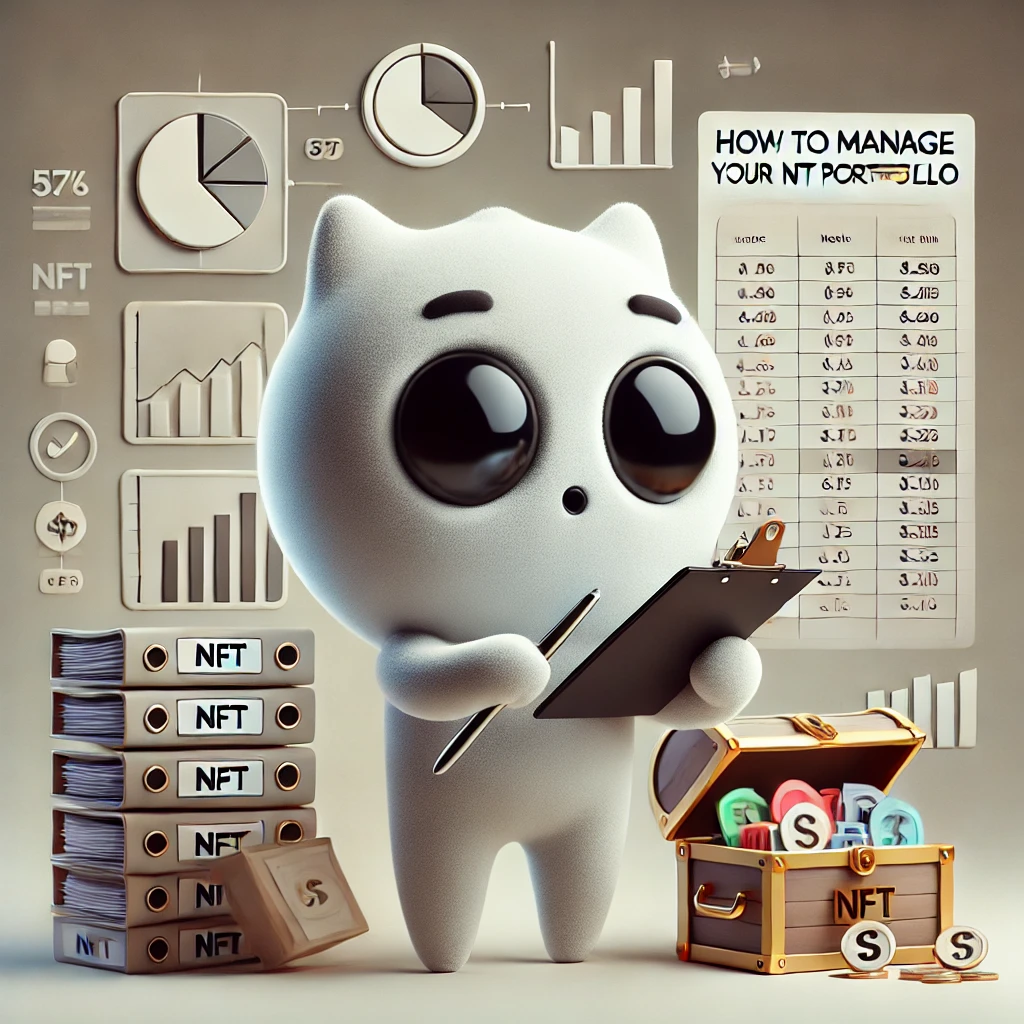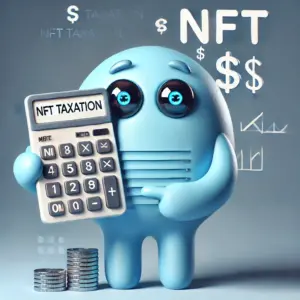The world of NFTs is a dynamic and rapidly evolving landscape, filled with exciting opportunities and potential pitfalls. As an investor, managing your NFT portfolio effectively is crucial to maximizing your profits and safeguarding your assets. This comprehensive guide will delve into the intricacies of NFT portfolio management, equipping you with the knowledge and strategies to navigate this exciting space with confidence.
Table of Contents:
Understanding the Basics
What is an NFT Portfolio?
An NFT portfolio is a collection of non-fungible tokens that you own. Similar to a traditional investment portfolio, it can encompass various types of NFTs, including:
- Art and collectibles
- Gaming assets
- Utility NFTs
- Domain names
- Music and video
Why Manage Your NFT Portfolio?
Managing your NFT portfolio effectively is essential for a multitude of reasons:
- Profit Maximization: By proactively analyzing market trends, identifying undervalued assets, and strategically buying and selling, you can increase your potential for profit.
- Risk Mitigation: Diversification across various NFT asset classes can help mitigate risk, reducing your exposure to any single asset category’s volatility.
- Enhanced Liquidity: An organized portfolio makes it easier to identify NFTs you may want to sell, enhancing your ability to access funds when needed.
- Long-Term Growth: A well-managed portfolio can foster long-term growth by ensuring optimal exposure to emerging trends and promising projects.
Essential Tools and Strategies
1. Choosing the Right Wallet
A reliable digital wallet is the cornerstone of your NFT portfolio. Consider factors such as security features, compatibility with your preferred blockchain, and user-friendliness. Some popular options include:
- MetaMask: A widely used browser extension and mobile app.
- Coinbase Wallet: A user-friendly option with a focus on accessibility.
- Trust Wallet: Known for its robust security features.
- Ledger Nano S: A hardware wallet offering maximum security.
2. Tracking Your Holdings
Maintaining a comprehensive record of your NFT holdings is crucial for making informed decisions. Several tools can aid in tracking your portfolio:
- NFT Portfolio Tracking Platforms: Services like NFTport and CoinMarketCap provide detailed tracking features, including price history, market capitalization, and portfolio performance.
- Spreadsheets: Simple spreadsheets can be effective for tracking basic information such as NFT name, purchase price, and current value.
- Dedicated NFT Portfolio Apps: Apps like NFTX and NFTKey provide users with real-time data and portfolio management tools.
3. Research and Due Diligence
Before making any investment, thorough research and due diligence are essential. Investigate the project’s team, roadmap, community engagement, technology, and tokenomics. Evaluate the following:
- Project Website: Analyze the website’s content, including whitepapers, roadmaps, and team details.
- Social Media Presence: Gauge community engagement and sentiment on platforms like Twitter and Discord.
- Media Coverage: Review articles and news stories about the project to understand its overall perception and reputation.
- Tokenomics: Scrutinize the project’s token distribution, token utility, and economic model.
4. Diversification and Risk Management
Diversifying your NFT portfolio across various asset classes and projects is paramount for risk management. Avoid putting all your eggs in one basket by allocating your funds proportionally to different categories. Consider the following:
- Project Type: Invest in a mix of projects spanning different verticals, such as art, gaming, and utility NFTs.
- Market Cap: Balance your investments across projects with varying market capitalizations, from emerging projects to established giants.
- Tokenomics: Diversify your investments by exploring projects with distinct token models and functionalities.
5. Staying Informed and Adapting
The NFT world is constantly evolving, so staying up-to-date on market trends, emerging technologies, and new projects is essential. Explore educational resources, follow industry influencers, and join relevant communities. Key areas to focus on include:
- Market Trends: Keep abreast of current market sentiment, price movements, and emerging trends in the NFT space.
- New Technologies: Stay informed about innovative technologies impacting the NFT ecosystem, such as Layer 2 scaling solutions and metaverse integrations.
- Community Engagement: Participate in discussions, attend virtual events, and connect with other NFT enthusiasts to gain insights and exchange ideas.
Strategies for Making the Most of Your NFT Portfolio
1. Identifying Growth Opportunities
Understanding the factors that drive NFT value is key to identifying growth opportunities. Analyze the intrinsic value of the asset, its potential for future utility or appreciation, and the strength of its community.
- Intrinsic Value: Look for NFTs with strong artistic merit, historical significance, or unique properties enhancing their value.
- Utility Potential: Assess the NFT’s potential for future use cases, such as access to exclusive content or virtual experiences.
- Community Support: A strong and engaged community can bolster an NFT’s value through increased demand and promotion.
2. Liquidity and Trading
Optimizing your portfolio for liquidity involves choosing NFTs readily tradable on reputable marketplaces. This allows you to access funds quickly if needed. Evaluate platforms such as:
- OpenSea: The largest NFT marketplace, featuring a vast selection of assets.
- Rarible: Known for its focus on community ownership and creator-friendly features.
- SuperRare: Specialized in curated digital art NFTs.
- Foundation: A platform that auctioned off NFTs to high-value collectors.
3. The Importance of Tax Considerations
Understanding your tax obligations is crucial when managing your NFT portfolio. Seek guidance from a qualified tax professional to ensure compliance with local regulations. Key considerations include:
- Capital Gains: Profit from selling an NFT is usually considered capital gains and subject to taxation.
- NFT Utility: The tax treatment of NFT use may vary depending on the specific functionality. For instance, utility NFTs providing access to a service could be taxed differently than pure collectibles.
4. Utilizing Portfolio Management Tools
Leverage tools specifically designed to streamline NFT portfolio management. These can assist with tracking, valuation, and analysis, enabling you to make data-driven decisions. Popular options include:
- NFT Portfolio Tracking Apps: Apps like NFTX and NFTKey offer real-time data, portfolio valuation, and management features.
- Cryptocurrency Tax Software: Platforms like CoinTracker and Cointracking can help you track your NFT transactions for tax reporting purposes.
5. Staying Ahead of the Curve
The NFT landscape is in a constant state of flux. Stay vigilant by following industry news, participating in online discussions, and attending relevant events to stay ahead of the curve.
- Online Communities: Join NFT-focused forums and communities to exchange ideas, learn from experienced investors, and gain insights into emerging trends.
- Industry Publications: Stay abreast of the latest developments in the NFT space by subscribing to industry newsletters and reading reputable publications.
- Events and Conferences: Attend virtual and in-person events to connect with industry leaders, explore new projects, and gain valuable insights.
Conclusion
Managing your NFT portfolio is an ongoing journey that demands vigilance, adaptability, and a deep understanding of the space. By implementing the strategies outlined in this guide, you can position yourself for success in this exciting and dynamic market. Remember to prioritize research, diversification, and continuous learning to navigate the evolving landscape of NFTs with confidence.
FAQs
What are some common mistakes to avoid when managing an NFT Portfolio?
Common mistakes to avoid include:
- FOMO (Fear Of Missing Out) investing: Don’t rush into investments solely based on hype or fear of missing out. Conduct thorough research before making any purchase.
- Over-diversification: While diversification is important, too much diversification can hinder your ability to profit from promising projects.
- Ignoring market trends: Stay informed about market shifts, price fluctuations, and emerging trends to make informed decisions.
- Not tracking your portfolio: Maintain a detailed record of your NFT holdings to understand performance, identify potential risks, and make informed investment choices.
How can I learn more about NFT portfolio management?
You can deepen your knowledge about NFT portfolio management by:
- Reading industry publications: Subscribe to reputable publications focused on NFT news, analysis, and investment strategies.
- Participating in online communities: Connect with experienced NFT investors on forums, subreddits, and Discord servers.
- Attending events and webinars: Virtual and in-person NFT events can provide valuable insights from industry experts and networking opportunities.
What are some resources for finding valuable NFT projects to invest in?
Several resources can help you discover promising NFT projects. Some options include:
- NFT aggregators: Platforms like NFTport and CoinMarketCap aggregate data from various marketplaces, allowing you to compare projects and identify potential investment opportunities.
- Community-driven platforms: Platforms like Discord and Twitter often host discussions and news about upcoming NFT projects, giving you early access to emerging trends.
- Industry publications and newsletters: Read articles and newsletters from reputable sources for insights into new project launches and investment analysis.






